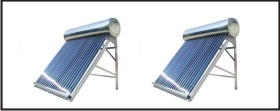Ravi Thermal System
Benefits of Solar Lights and Lanterns for the rural world..

Extends the Working day in rural areas -
On average it is dark by 6:30 year round. Solar Lighting allows rural families to extend their workday into the evening hours. Many villages where solar lights are installed see a increase in their economic activitiy levels. Installing Solar lights in villages allows businesses to operate during the evening. Solar electricity helps promote local enterprises as small shops and village markets can use the systems to provide lighting to operate during the evening.
Improves Health issues -
Fumes from kerosene lamps in poorly ventilated houses are a serious health problem in much of the world where electric light is unavailable. The World Bank estimates that 780 million women and children breathing kerosene fumes inhale the equivalent of smoke from 2 packs of cigarettes a day. By the use of Solar Lanterns these issues are resolved.
Stems Urban Migration -
Improving the quality of life through solar lighting at the rural household and village level helps stem migration to mega-cities. Also, studies have shown a direct correlation between the availability of proper light and lower birth rates in some studies.
Improves Fire-Reduction -
Kerosene lamps are a serious fire hazard in the developing world, killing and maiming tens of thousands of people each year. Kerosene, diesel fuel and gasoline stored for lamps and small generators are also a safety threat, whereas solar
electric light comes as the safest measure for all.
Improves Literacy rate -
Solar light improves literacy, because people can read after dark more easily than they can by candle or lamp light. School work improves and eye sight is safeguarded when children study by solar powered light. With the advent of television and radio, people previously cut off from electronic information, education, and entertainment can become part of the modern world without leaving home.
Saves Energy -
Solar electricity for the Third World is clearly the most effective energy conservation program because it conserves costly conventional power for urban areas, town market centers, and industrial and commercial uses, leaving decentralized PV-generated power to provide the lighting and basic electrical needs of the majority of the developing world's rural populations.
Reduces Maintenance -
Use of a solar light rather than gensets or kerosene lamps reduces the time and expense of refueling and maintenance. Kerosene lamps and diesel generators must be filled several times per day. In rural areas, purchasing and transporting of kerosene or diesel fuel is often both difficult and expensive. Diesel generators require periodic maintenance and have a short lifespan. Car batteries, used to power TVs must often be transported miles for recharging. They require no fuel, and will last for several years with minimal servicing.
Reduces local air pollution -
Use of solar electric systems decreases the amount of local air pollution. With a decrease in the amount of kerosene used for lighting, there is a corresponding reduction in the amount of local pollution produced. Solar rural electrification also decreases the amount of electricity needed from small diesel generators.
Offsets greenhouse gases -
Photovoltaic systems produce electric power with no carbon dioxide (CO2) emissions. Carbon emission offset is calculated at approximately 6 tons of CO2 over the twenty-year life of one PV system.
Increases effectiveness of health programs -
Use of a solar electric lighting systems by rural health centers increases the quality of health care provided. Solar electric systems improve patient diagnoses through brighter task lighting. Even today, child birth happens at rural homes having no access to electricity, supplying a regulated amount of light through solar lanterns will improve and make child birth easier.